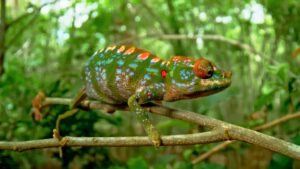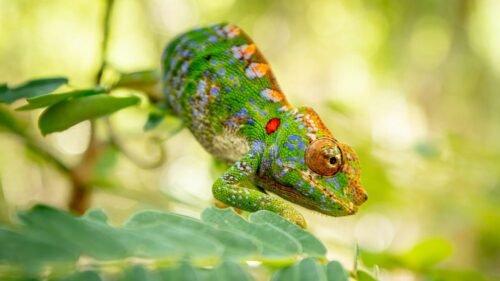Have you ever wondered, “Can chameleons swim?” If so, you’re not alone. It’s a common question among reptile enthusiasts and new pet owners. With their vibrant colors, unique behaviors, and ability to change skin tones, chameleons are one of the most fascinating creatures to keep as pets. But there’s one myth that often confuses chameleon owners—can they actually swim?
In this article, we’re going to dive deep into this question, explore the truth behind chameleons and water, and provide you with all the essential information you need to ensure your chameleon stays healthy and safe. If you want to be a responsible pet owner and learn about your chameleon’s natural behavior, keep reading!
Understanding Chameleon Biology

Before we get into whether or not chameleons can swim, let’s first take a look at their anatomy and biology. Understanding how these incredible creatures are built will help you understand why they’re not suited for life in water.
Chameleon Anatomy: Designed for Life on Land
Chameleons belong to the family Chamaeleonidae, and like other reptiles, they are built for life on land. Unlike amphibians, which are adapted for both land and aquatic environments, chameleons are strictly terrestrial creatures. Their anatomy is designed to help them thrive in trees and bushes, not in water.
- Limbs and Feet: One of the most notable features of a chameleon is its unique feet. Their toes are fused into two separate “claws,” which help them grip tree branches and leaves. This adaptation is great for climbing but isn’t ideal for swimming or moving in water.
- Tail: Chameleons also have prehensile tails, which are another adaptation for climbing. Their tails are long and muscular, providing extra support when they move through trees. In water, this tail wouldn’t serve the same purpose—it’s not streamlined like that of an aquatic animal.
- Skin: Chameleons are known for their ability to change colors, which helps them regulate temperature and communicate. However, their skin is designed to withstand dry conditions rather than being submerged in water. Prolonged exposure to moisture can harm their sensitive skin.
- Respiratory System: Chameleons breathe air, and they are not equipped with the specialized gills or lungs needed for aquatic life. Their respiratory system functions well in dry air but can struggle if submerged in water.
Chameleon Behavior: Adapted for Dry Environments
In the wild, chameleons are native to warm, dry environments such as Madagascar, parts of Africa, and the Middle East. Their habitats are usually covered in thick vegetation and trees, where they can easily blend into their surroundings and hunt for insects. In these areas, water sources are limited, and the chameleon’s primary source of moisture comes from dew, rain, and mist rather than large bodies of water.
Chameleons aren’t equipped to live in aquatic environments. Unlike amphibians that can breathe both through their skin and lungs, chameleons breathe through their lungs and need dry, well-ventilated areas to stay healthy. They are not swimmers by nature, and most will avoid water if they can.
Can Chameleons Swim?
Now, let’s get to the heart of the matter: Can chameleons swim? The short answer is: No, chameleons are not natural swimmers. While some reptiles, like turtles and alligators, have evolved to be excellent swimmers, chameleons have not. They are not built for life in water and typically do not enjoy or thrive in it. However, there are some nuances to this answer that we need to explore further.
The Myth of Chameleon Swimming
Many people have heard rumors or seen videos online of chameleons “swimming” or floating in water. While it is true that a chameleon can stay afloat in water for a short time, this doesn’t mean they are swimming or that they are naturally adapted to water. What you’re most likely seeing is a chameleon floating or “bobbing” in the water, but they’re not swimming like an amphibian or a fish would.
Chameleons are incredibly skilled at using their limbs to maintain balance, and they might use their legs to paddle gently in water. However, this is more of a survival response if they find themselves in water, rather than a behavior they actively engage in. It’s essential to remember that chameleons don’t possess the strong, muscular tails or streamlined bodies needed for efficient swimming.
What Happens When Chameleons Are Exposed to Water?
Chameleons are territorial and highly sensitive creatures. They can become stressed by any situation that feels unfamiliar or dangerous to them—being submerged in water is definitely one of those situations. Prolonged exposure to water can cause a variety of health problems for a chameleon.
- Stress: Chameleons are solitary animals and don’t naturally seek out water. Placing a chameleon in water—whether it’s in a bath, pond, or pool—can lead to significant stress. Stress is a major contributor to illness in reptiles and can weaken their immune system.
- Risk of Drowning: While chameleons can float for a short time, they are not skilled swimmers, and there’s a real risk of drowning if they are left in water for too long. Even though they may paddle around instinctively, they may struggle to keep their head above water for extended periods.
- Skin Issues: Chameleon skin is highly sensitive. Prolonged moisture exposure, especially in stagnant or non-moving water, can lead to skin irritation, fungal infections, or even respiratory infections.
The Dangers of Water for Chameleons
While a chameleon might seem fine in water for a brief period, the risks involved far outweigh any potential benefits. Here’s why:
Drowning: A Serious Concern
As mentioned earlier, chameleons do not have the physical adaptations necessary for swimming, such as webbed feet or streamlined bodies. When placed in water, they might struggle to stay afloat or find it difficult to get out.
This is particularly dangerous if the chameleon is left in a pool, bathtub, or any body of water where they cannot easily escape. It’s essential to remember that even though a chameleon might seem fine in the water for a few moments, the longer they remain in it, the higher the risk of drowning.
Skin and Respiratory Health Issues
Chameleons rely on their skin to maintain hydration and regulate their body temperature. Prolonged exposure to water, particularly standing water, can disrupt the delicate balance of their skin.
It can also expose them to bacteria, fungi, and other pathogens that can lead to skin and respiratory infections. In the wild, chameleons naturally avoid getting too wet. They get moisture from rain, dew, or misting, but they don’t submerge themselves in bodies of water.
Stress and Anxiety
Chameleons are solitary creatures that value their personal space. If they feel trapped or exposed to danger—such as being placed in an unfamiliar environment like a pool or bathtub—they can experience intense stress. Stress can lead to a weakened immune system, which makes them more susceptible to illness and disease. Long-term stress can even lead to issues with feeding, breeding, and overall health.
Proper Care for Your Chameleon

If you’re a chameleon owner, it’s essential to understand the proper care requirements for your pet. Here’s how you can create a safe, healthy environment for your chameleon without risking water exposure:
Humidity Control: The Right Way to Hydrate Your Chameleon
Chameleons do not need water in their enclosure in the form of a pool or a pond. Instead, they require humidity, which can be easily achieved through misting. Most chameleons thrive in a humid environment, but it’s important to avoid making their enclosure too wet.
- Misting: Regular misting is one of the best ways to ensure your chameleon stays hydrated. You can use a hand-held spray bottle or install an automatic misting system to keep the humidity at an optimal level.
- Water Droplets: Chameleons often drink by licking water droplets from plants or leaves. It’s a natural behavior for them to seek out moisture this way, so make sure to include some foliage in their enclosure for them to drink from.
- Water Dish: If you want to offer a water dish, make sure it is shallow and cannot be easily accessed for bathing. The dish should be there for drinking purposes only, and it should not encourage your chameleon to immerse themselves in it.
Temperature and Lighting: Simulating Natural Conditions
Chameleons are cold-blooded, so their environment needs to mimic their natural habitat. The temperature and lighting in their enclosure should provide both warmth and a gradient for the chameleon to regulate its body temperature.
- Basking Spot: Chameleons need a basking spot with a temperature of around 85–95°F (29–35°C). This allows them to absorb heat and digest food.
- UVB Lighting: Chameleons require UVB lighting to help synthesize vitamin D3, which is essential for calcium absorption. Without UVB, they can develop metabolic bone disease.
Alternative Methods to Hydrate Your Chameleon
If your chameleon is not getting enough water, there are alternative methods you can use to ensure they stay hydrated without exposing them to water-related risks.
- Drip Systems: A drip system can be installed in the enclosure to slowly release water onto a plant or surface. This mimics the natural water sources chameleons would encounter in their native habitats and allows them to drink from droplets.
- Regular Mistings: Misting with clean, room-temperature water is a great way to increase the humidity and provide hydration. Chameleons often drink from the mist as it collects on leaves and branches.
Conclusion
So, can chameleons swim? While the answer is technically yes, they can float or paddle in water for short periods, they are not built to swim or thrive in aquatic environments. Chameleons are terrestrial animals that require careful attention to their humidity and hydration needs, not water-based activities.
By creating the right environment and understanding their natural behaviors, you can ensure your chameleon remains healthy and stress-free. Avoid exposing them to water where they could be at risk of drowning or skin infections. With proper care, your chameleon will thrive in a dry, humid environment that mimics their natural habitat.

